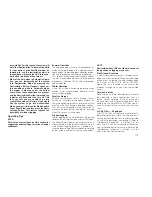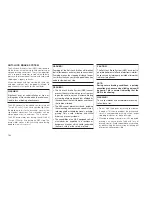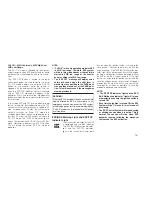
3. Move the 4WD Control Switch to the desired
position.
4. After the desired position indicator light is ON
(not flashing), shift the transmission into gear
(automatic transmission), or release the clutch
pedal (manual transmission).
NOTE:
•
Steps 1 and 2 in the “Preferred Procedure”
and the “Alternate Procedure” are require-
ments for shifting the transfer case. If these
requirements are not met prior to attempting
the shift or while the shift attempt is in
process, then the indicator light will flash,
and the current transfer case position will be
maintained. To retry a shift, move the 4WD
Control Switch back to the original position,
make certain all shift requirements have
been met, wait five seconds, and try the shift
again.
•
The ignition switch must be in the ON posi-
tion for a shift to take place and for the
position indicator lights to be operable. If
the ignition switch is not in the ON position,
then the shift will not take place, and no
position indicator lights will be on or flash-
ing.
ON-ROAD DRIVING TIPS
Utility vehicles have higher ground clearance and
a narrower track to make them capable of per-
forming in a wide variety of off-road applications.
Specific design characteristics give them a higher
center of gravity than ordinary cars.
An advantage of the higher ground clearance is a
better view of the road, allowing you to anticipate
problems. They are not designed for cornering at
the same speeds as conventional 2–wheel drive
vehicles any more than low-slung sports cars are
designed to perform satisfactorily in off-road con-
ditions. If at all possible, avoid sharp turns or
abrupt maneuvers. As with other vehicles of this
type, failure to operate this vehicle correctly may
result in loss of control or vehicle rollover.
OFF-ROAD DRIVING TIPS
When To Use 4WD LOW Range
When off-road driving, shift to 4WD LOW for
additional traction and control on slippery or diffi-
cult terrain, ascending or descending steep hills,
and to increase low-speed pulling power. This
range should be limited to extreme situations such
as deep snow, mud, or sand where additional low
speed pulling power is needed. Vehicle speeds in
excess of 25 mph (40 km/h) should be avoided
when in 4WD LOW range.
Driving Through Water
Although your vehicle is capable of driving
through water, there are a number of precautions
that must be considered before entering the wa-
ter:
CAUTION!
When driving through water, do not exceed 5
mph (8 km/h). Always check water depth before
entering as a precaution, and check all fluids
afterward. Driving through water may cause
damage that may not be covered by the new
vehicle limited warranty.
Driving through water more than a few inches/
centimeters deep will require extra caution to
ensure safety and prevent damage to your ve-
hicle. If you must drive through water, try to
determine the depth and the bottom condition
(and location of any obstacles) prior to entering.
Proceed with caution and maintain a steady con-
trolled speed less than 5 mph (8 km/h) in deep
water to minimize wave effects.
Flowing Water
If the water is swift flowing and rising (as in storm
run-off) avoid crossing until the water level re-
cedes and/or the flow rate is reduced. If you must
cross flowing-water, avoid depths in excess of 9 in
131
Summary of Contents for Cherokee 2009
Page 1: ......
Page 2: ......
Page 3: ......
Page 5: ...2...
Page 9: ...6...
Page 11: ...8...
Page 15: ......
Page 45: ...42...
Page 50: ...Rear Window Defroster If Equipped 89 ROOF LUGGAGE RACK IF EQUIPPED 90 47...
Page 51: ......
Page 63: ...60...
Page 64: ...61...
Page 65: ...62...
Page 97: ...INSTRUMENT CLUSTER 94...
Page 106: ...Compass Variance Map 103...
Page 111: ...Compass Variance Map 108...
Page 116: ......
Page 120: ...117...
Page 123: ...Control Setting Suggestions for Various Weather Conditions 120...
Page 147: ......
Page 159: ......
Page 162: ......
Page 175: ...172...
Page 179: ......
Page 210: ...9 IF YOU NEED CONSUMER ASSISTANCE IF YOU NEED ASSISTANCE 208 207...
Page 212: ...209...
Page 213: ...210...
Page 214: ...10 INDEX 211...
















































